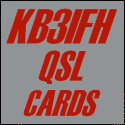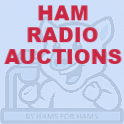Posts Tagged ‘field day’
 Taking things for granted
Taking things for granted
Before I start this post, I want to dispel any rumors that all W2LJ does at Field Day is take photographs. Here are two of yours truly actually pounding brass and adding points to the NJ2SP Field Day total - courtesy of Mario KD2HPF.
 |
Field Day, or perhaps better said, the end of Field Day often causes me to wax nostalgic. That definitely happened this year, and a large part of it was seen in that video which I posted yesterday. Watching Marv K2VHW working ZL4TT in New Zealand brought back me back, in an instant, to something that happened to me, as a newly licensed Amateur Radio operator so many years ago.
A little context - Bill W2AOF, our Club President, spent a month with friends in New Zealand earlier this year. When he got back, he filled us in on the details of the trip. He had a great time, got to see a lot of wonderful sights, got to eat good food and spend quality time with good people. Yet, there was a price to pay, and I'm not referring to the monetary expense. Sure, there was that, but there was also an expenditure of time.
With all the technological advancements we've witnessed over the last century, getting to New Zealand from New Jersey is comparatively easy compared to 100 years ago. Back then, the ocean voyage took weeks. Flying by air is a snap compared to that, but even that takes time. You don't often think about it, but even flying on a commercial aircraft, going at speeds never dreamt of by the seafaring ships of the old days, it still takes the better part of a day (around 18 hours) to get from New Jersey to New Zealand. And in the middle of the overnight, in the wee hours of Sunday morning, with 5 Watts of power to a hunk of wire hanging in the air, we made that trip and back in seconds, the whole conversation taking a few minutes!
I was struck by that, once again. I wish Bill had been there. He had left a few hours earlier to make sure the A/C was working properly in his home as well as to get some much needed rest. Had he been there. Bill is the kind of guy who would have been taken aback and would have experienced that "Wow factor" of what had just been accomplished. We communicate with all parts of the world. There is really no place too far that our radio waves can't reach. But how often do we let that soak in? How often do we get annoyed when that DX contact isn't made. How often do we take our radios and our hobby and all the physics involved for granted?
I guess I'm one of the lucky ones, as I had a similar experience happen to me back in 1979, and I'm sure it's been related somewhere earlier in this blog. But I like to think about it, it's an enjoyable memory and I'll re-tell it again.
I passed my Novice exam sometime back in October/November of 1978. The actual paper "ticket" came in the mail the last week of the year. I didn't even get on the air until the end of January of 1979, as I was busy putting my station together, and building my Heathkit Novice receiver kit that I had gotten as a Christmas gift. I upgraded to General in July and I worked my first DX contact with a Ham in Germany shortly thereafter.
Later that year in October of 1979, my best friend and I decided to take a trip up to the White Mountains in New Hampshire to do some photography. We were two young budding photographers who were working together at a local camera shop and we both needed a road trip. We got our much needed time off and eventually made it all the way to Maine, specifically Bar Harbor. From there we decided that we would follow the coast as we made our way back to New Jersey.
That meant a side trip to Cape Cod, and on the way out to Provincetown for some authentic New England clam chowder we came across a sign indicating that we were approaching the site of Marconi's Wellfleet Station. I had to stop. We were in my car and I was the driver, so what I say goes .....goes. Right? What newly minted Amateur Radio operator would not want to visit a Marconi site?
Not my image, but this is what you see when you visit. ^ This site is part of the National Park's Cape Cod National Seashore entity, so it is well maintained and there is a plethora of history to read about. This is what it looked like back in the day:
A few of the cement pylons that anchored the legs of the antenna towers were still there when I visited. Most had washed away into the sea as a result of beach erosion.
But it was the sea that struck me the most, which is a strange thing to say as I was born, bred and continue to live in New Jersey. I've seen the Atlantic Ocean and it bays hundreds, if not close to a thousand times in my time here on earth. But that time was different.
I had not yet traveled to Switzerland, and would not experience air travel to Europe for another nine years, but standing there, for a VERY long time, where history had been made, just staring at the ocean, looking out upon all that water as far as my eye could see, was an experience unlike any other I had ever had. All I could think of was the radio waves from my Drake 2-NT and my MorGain multiband dipole, flying over all that water to another Ham in Germany. And her radio waves (she was an XYL) travelling back to my Heathkit HR-1680 receiver in a matter of seconds.
That water looked like it would never end. I knew that it did. I knew that on the other side of that vastness was Europe and the rest of the world. To contemplate my radio signals covering all that distance made me feel so tiny, but also filled me with awe at the immensity of Creation at the same time.
We get so busy on Field Day and the rest of the year with making contacts, conducting ragchews, running nets, competing in contests, speaking into microphones, banging away on keys, typing away on keyboards that we forget to notice what is really happening. It's the magical part of Amateur Radio that never grows old for me and I hope I never take it for granted.
Long winded, I know, but thanks for staying with me!
72 de Larry W2LJ
QRP - When you care to send the very least!
 Winter Field Day 2023 (Jan 28, 29 UTC)
Winter Field Day 2023 (Jan 28, 29 UTC)
Join the Winter Field Day!
You do NOT have to operate from a cold location; home operation is an allowed category.
Winter Field Day is a communications exercise. WFD is held on the last full weekend in January. WFD can be worked from the comfort of your home or in a remote location. You can participate by yourself or get your friends, family, or whole club involved. Winter Field Day is open to participants worldwide. Amateur radio operators may use frequencies on the HF, VHF, or UHF bands and are free to use any mode that can faithfully transmit the required exchange intact. Similar to the ARRL’s Field Day, bonus points are earned in several ways, including using non-commercial power sources, operating from remote locations, satellite contacts, and more.
Winter Field Day is sponsored by the Winter Field Day Association. We passionately believe that Ham radio operators should practice portable emergency communications in winter environments as the potential for freezing temperatures, snow, ice, and other hazards present unique operational concerns. WFD is formatted to help increase your level of preparedness for disasters and improve your operational skills in subpar conditions. Click here to read more about the history and purpose of winter field day.
Do check out the rules, as there are some important things you must know.
During the last weekend in January, ham radio operators worldwide participate in Winter Field Day. We encourage you to grab your radio, get outside and join us during this uniquely challenging event. Click on the links below to view our 2023 Rules and our Resources page. The Resources page has a plethora of information, including FAQs, logging software recommendations, operating aids, and more.
Website: https://www.winterfieldday.com/
 Hearing Too Much and Not Enough…of the Right Signal!
Hearing Too Much and Not Enough…of the Right Signal!
Field Day is once again happening later this month. Hearing everyone is a blast, no? Well, it might not be. Especially if it’s the ham at the table right next to you. The “sshh, sshh” sound of the CW op bleeding over into your SSB ban frequency or the nearby FT8 transmissions doing the same. But you’re forgetting the CW op hearing your voice signal peaks, too. Unless you’re listening to the monitor on FT8 (or other digital mode), you just might not reliably decode a QSO transmission. All in all, it’s just not the folks whom you want hear!
It might be time to include an HF bandpass filter system into your Field Day or other portable operation station(s). But what to do? Build a kit? Buy commercially assembled? Or some of both? This is the focus of my article that appears in the June issue of CQ Magazine.
I bought an HF BPF system covering 160-6 meters from an Australian company, VK-Amps, from their eBay store at a very good price. Here’s a picture of the assembly into a customized aluminum case on my workbench. I tested it for filter characterization comparison against N5DU’s DX Engineering’s comparable DXE-419 filter system. My portable ops team tested the two during the Mississippi QSO Party. How did it do? Take a look at CQ Magazine’s June issue!
 I Participated in Field Day 2020 — and Got the Tee Shirt!
I Participated in Field Day 2020 — and Got the Tee Shirt!
OK, this is a cheesy blog post title. But it’s true. Here’s the picture…and it leads into more important things about Field Day.

My annual Field Day plans are spotty at best due to my wedding anniversary falling near that June weekend. I’ve participated in multi-club “big” Field Day events here in Central Mississippi in previous years. But, frankly, I don’t enjoy them. I prefer a smaller event when it doesn’t conflict with our anniversary plans. This year our planned trip to the UP in Michigan was up-ended by the Covid-19 pandemic. So when my portable ops partner, Mike N5DU, invited me to come out to his farm in Raymond, MS on Saturday, that seemed perfect!

He also invited a new ham in the area, Kyle KI5JCL, to come and learn more about Field Day. Kyle works in the IT field so his “JCL” call sign suffix gave me vivid memories of the days when I worked on the Big Iron, IBM mainframes at the Triangle Universities Computation Center (TUCC) while on the faculty at NC State. (For the uninitiated, JCL was IBM’s nomenclature for Job Control Language.) Kyle checked into our club’s weekly 2 meter net which is how we got to know him. This was a chance to play Elmer to a very tech-savvy, only licensed for a month, ham in our area. While a tad nervous to jump into the pile-up held by a Western PA ham, Kyle worked on him for about 20 minutes before he heard the November Five Delta Uniform phrase coming back to him. Mike and I stood and clapped heartily for Kyle as he stayed with that big fish and finally landed him. Fine Business! The ham in PA may never know how significant he was for the calling amateur on this end of the QSO.
N5DU has a small separate building adjacent to his home for his ham shack, an almost perfect setting from my point of view. It’s in the country on a family farm acreage where there are no deed restrictions on antennas (except internal approval in the household unit, of course) and with almost no RF noise. The N5DU team used a Kenwood TS-590SG feeding an Ameritron ALS-1306 amplifier, an MFJ ATU feeding a Windom about 30′ up among trees. We also exercised a digital station, first on a Xiegu 5105 and then on an Icom 7200. The digital station fed an MFJ-2982 vertical. FT8 was the digital mode of choice. We rotated among the voice and digital stations and…well, all of the snacks and great food Mike’s XYL had on hand for us.

While we didn’t mark any achievements on the scoreboard of this “non-contest, contest” that is Field Day, the N5DU team (led by Mike, frankly) finished with 328 points over 268 contacts. We were missing our CW op, Mike K5XU as well as Thomas N5WDG on this one!

Getting a good group together to share knowledge, skills and suggestions is always a good thing. I have learned a great deal from Mike N5DU, especially on style of operating during a contest. It’s not always about points, Boom! Boom! Boom! But working with ops who are either just getting started or who just stumble across something like this Covid-19 lots-of-teams-working-separately-at-home Field Day is important too. The ARRL’s temporary rule modification to allow home stations to work each other make a notable difference on the band waterfall displays. Watch this video, especially of Mike spending a few moments (and likely losing a couple of contacts during the time where he was clipping along at a 93 contacts-per-hour pace).
It’s fairly obvious that power makes a difference. We were able to hold frequencies and work them for an hour at a time. Having a tower and beam in addition would’ve just underscored that situation. We moved from QRP on digital to upwards of 40 watts or so on the Icom 7200. In some ways, the need to “handicap” contest stations will make a huge difference in the long run for highly competitive contests. But on Field Day 2020, I was just glad to participate in a small team, learn from one another, and getting a Tee Shirt to commemorate the event. Thanks for the gift, N5DU!
 Creativity Opportunities
Creativity Opportunities
In social media circles there has been much discussion about Field Day in light of COVID-19 restrictions. Many traditional club operations are going to be cancelled this year due to social distancing requirements and the need to protect ourselves and especially vulnerable members of our population, of which there are many in amateur radio.
Folks are going to continue to participate from home this year. Many people undoubtedly are going to recreate the “traditional” FD experience they are accustomed to, operating in their backyard, perhaps in a tent with temporary antennas, emergency power, a grill, and some cold 807s.
Participants operating at home must operate either as D or E class. D class stations use commercial power while E class uses emergency power sources. D class stations cannot contact other D stations for points. E class stations can contact any other class station. For those wanting to operate in their backyard with tents, emergency power, and temporary antennas, with the way the rules are currently written, they are required to operate as E class. This puts them in competition with other E stations that choose to operate in the comfort of their homes using permanent antennas. This would include antennas like a rotatable beam on an 80′ tower. So participants choosing to operate in their backyard with what would otherwise be a common field station, as 1E are at a disadvantage. It would be more fair to allow backyard stations to operate as class B.
There have also been calls for ARRL to remove the D class contact limitation. This would give D stations more opportunities to make contacts than they usually could, but considering the unprecedented situation this year and the likelihood of a large majority of D class stations, it would seem removing the restriction would make sense.
ARRL has noted they will not publish aggregated club scores. Doing so would be a benefit for clubs that are unable to have their normal FD operations and have members operating from home. There could be an “Aggregate Club Home Score” reporting category created. Considering that all FD score data is probably stored in a database, producing such a reporting category would be trivial.
Undoubtedly there are other one time tweaks and adjustments that could be made this year in light of the situation we’re in. I can’t understand why ARRL hasn’t been more flexible and creative this year and used the circumstances as an opportunity to officially recognize the flexibility and creativity of participants, and instead has ironically asked participants to be creative, but stay within the lines of the current rules.
This article was originally posted at Radio Artisan.
 Answers to Top 10 Field Day Questions
Answers to Top 10 Field Day Questions
Answers to the top 10 questions at Field Day, with questions omitted (and with 5 bonus answers):
15. Snakes.
14. Yes, I still hear the interference.
13. Behind that tree over there.
12. Because he knows his callsign and you don’t have to tell it to him three times.
11. Hit Return.
10. Hot.
9. Try rebooting it.
8. It doesn’t matter. It’s not up high enough to have any directivity.
7. Just say QSL.
6. Rain.
5. Yes, this frequency is in use.
4. It’s on the sign right above the rig.
3. I filled it up an hour ago. It’s good.
2. Yes, it’s done in the middle.
1. Hamburger.
This article was originally posted on Radio Artisan by a team of laptop-equipped squirrels.
 LHS Episode #161: Someone Spelt the Soup
LHS Episode #161: Someone Spelt the Soup
 This is a very exciting episode of Linux in the Ham Shack for us. It's so special, that it's a double episode! That's right, it's like getting two episodes in one. Your hosts (one of them new to the program) discuss winter field day, WxBot, the origin of Debian Linux, SSTV using Linux, OpenSSH security concerns, solving the Rubik's Cube with Linux and a whole lot more. Hope you enjoy, and please welcome our new host!
This is a very exciting episode of Linux in the Ham Shack for us. It's so special, that it's a double episode! That's right, it's like getting two episodes in one. Your hosts (one of them new to the program) discuss winter field day, WxBot, the origin of Debian Linux, SSTV using Linux, OpenSSH security concerns, solving the Rubik's Cube with Linux and a whole lot more. Hope you enjoy, and please welcome our new host!
73 de The LHS Crew
















